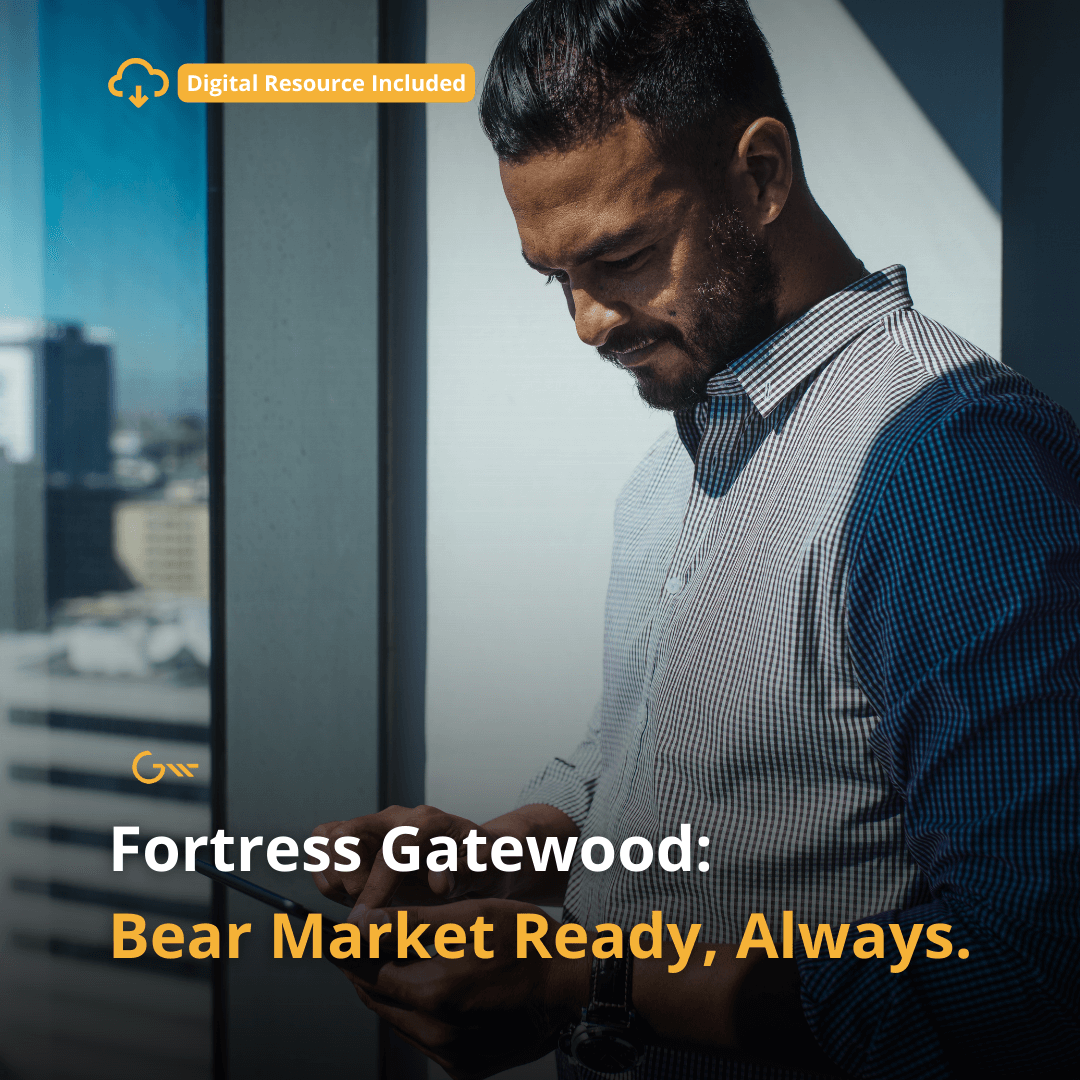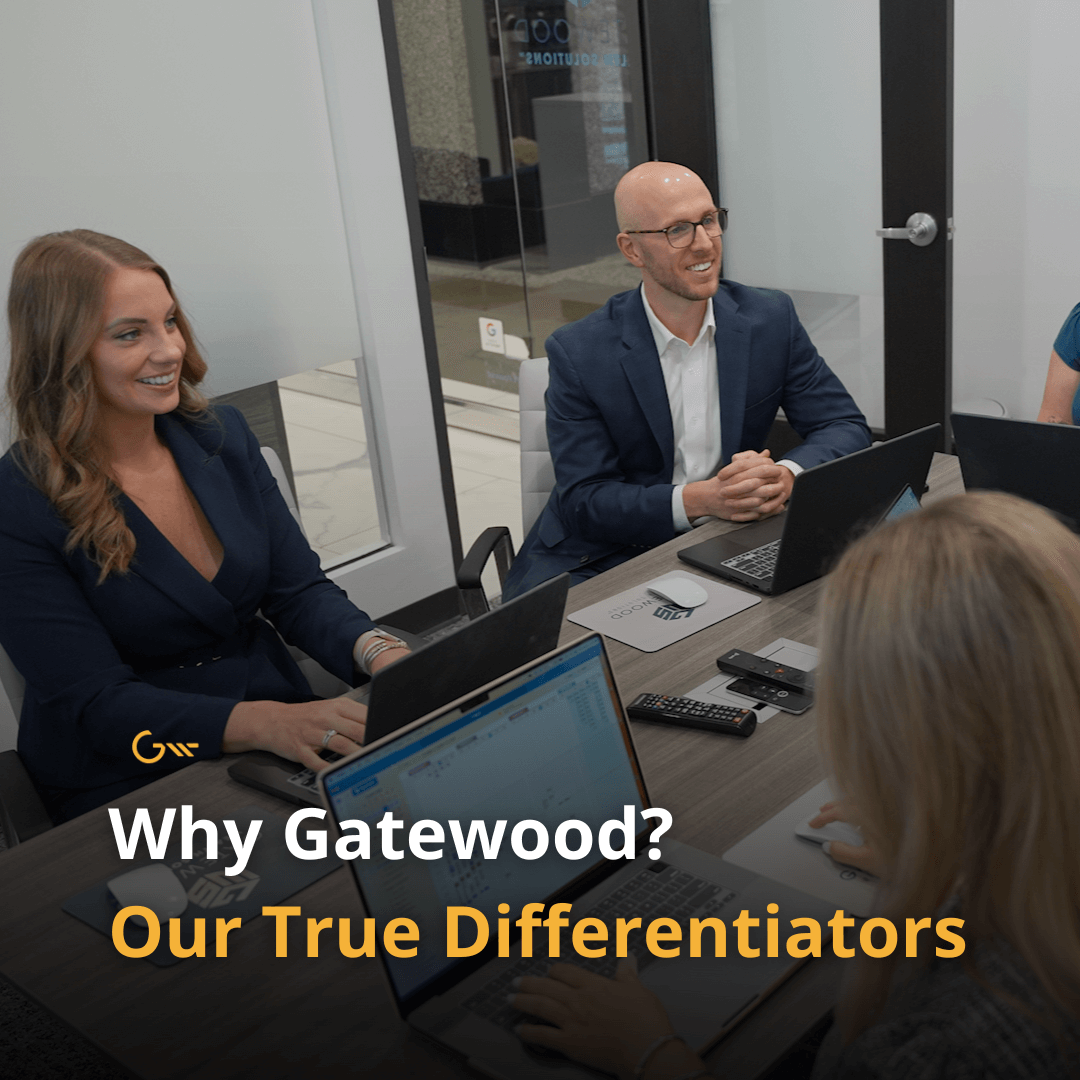At Gatewood, we’ve spent decades crafting an experience so personal and comprehensive that it can’t be easily copied. We believe in a Firm-to-Family model where relationships span generations, backed by in-house investment management, industry-leading technology, and a genuine commitment to excellence and independence. Below, I’ll break down exactly how we stand apart—and why so many families value our insight into their long-term financial well-being.
Competitor Comparison – What Sets Us Apart
| Feature |
Gatewood |
Typical Advisory Services Firm |
| Client Ownership |
Firm-to-Family Model (Clients belong to the firm) |
Advisor-Owned (Each advisor runs their own book) |
| Investment Management |
In-House |
Mostly Outsourced |
| Cash Management |
Real-Time Dynamic Planning |
Static One-Time Planning |
| Technology Spend |
Industry-Leading |
Minimal Investment |
| Advisor Age & Continuity |
Multigenerational Team |
Advisors Nearing Retirement |
| Market Risk Management |
Cash Buffers, Profit-Taking |
“Stay the Course” Approach |
| Product Sales |
No Proprietary Products |
Often Push Own Products |
| Firm Independence |
No Private Equity |
Many Firms Sell to PE |
1. One Firm, One Family – Firm-to-Family vs. Advisor-to-Client
“Most firms operate under an advisor-to-client model, where your financial success hinges on one individual. If that person retires or leaves, you’re often left starting over. We do it differently.” – John Gatewood, CFP®, CLU®, Founder & Director of Advisor Development
True Client Ownership by the Firm
Unlike many firms, we don’t function as a set of individual advisors, each claiming their own “book of business.” Every Gatewood client is a client of the entire firm, ensuring smoother transitions and consistent care.
Dedicated Client Care Team
Instead of chasing a single busy advisor, each Gatewood family works with a specialized Client Care Team, including:
- A Wealth Advisor as your relationship manager
- A CFP® Wealth Planner to integrate every aspect of your financial life and provide excellent advice
- A Wealth Coordinator to manage administrative details and daily service requests
Consistent Policies & Seamless Transition
This firm-wide approach standardizes the client experience. If one of your advisors steps away, the rest of the team knows you and your family intimately, ensuring continuity and confidence.
Why competitors struggle to replicate this:
They often operate under big umbrella brands, with disparate advisors who follow different strategies. Shifting to a uniform Firm-to-Family model requires a massive cultural overhaul—no easy feat.
2. In-House Investment Management – No Outsourcing, No Middlemen, No Conflicts
“We don’t outsource your portfolio to an external manager. Our Investment Committee makes decisions internally—so you can talk directly to the people managing your money.” – Christopher Arends, CFA®, CMT®, CAIA® , Chief Investment Officer
Proprietary Strategies
At Gatewood, all investment strategies are managed in-house, backed by a blend of technical analysis, quantitative trends, and daily research. We can trim profits when markets peak, maintain strategic cash reserves, and adapt quickly to shifts—all with your goals in mind.
Direct Access to Decision-Makers
Many firms separate the client from the people who actually pick stocks or structure portfolios. Not here. You have direct access to our Investment Committee to better understand the rationale behind each investment decision. This is your money, not ours. You deserve to deeply understand how we are acting on your behalf.
Why competitors can’t do this:
Either they outsource to third-party managers, or they lean on a centralized, far-off department. Both limit flexibility and create barriers to true personalization. Oftentimes, this comes with conflicts of interest and entangling relationships with fund companies. We believe keeping everything in house is essential to acting as a true fiduciary for the families and businesses we serve.
3. The Cash Hub Account & Dynamic Financial Planning – Smarter Retirement Income
“One of the biggest financial mistakes people make is selling in a downturn. Our Cash Hub approach helps you avoid that trap.” – Christina Shockley, JD, CFP®, Partner & Chief Planning Officer
Strategic Cash Reserves
We generally recommend holding 6 to 30 months’ worth of expenses—depending on one’s life stage and market conditions—to avoid forced selling during downturns. This “Cash Hub” strategy is the backbone of our planning process. Our Investment Committee sets policy for our entire firm quarterly to ensure we are consistently preparing for market downturns.
Dynamic Adjustments
We don’t set it and forget it. Life changes constantly, so our team adjusts your cash reserves in real time. Whether you’re buying a home, funding college tuition, or facing unforeseen events, we integrate new information into your plan continuously.
Why competitors can’t do this:
Some advisors push clients to invest every spare dollar (that’s how they earn fees) and rely on lines of credit for liquidity. Others do static, one-time plans that never get updated. Without ongoing, interactive planning, maintaining an optimal cash buffer is nearly impossible leaving many families unprotected for the next bear market.
4. Industry-Leading Technology Investment – A Major Barrier to Entry
“Our tech stack synchronizes planning, trading, and operations in real-time. That means no detail falls through the cracks.” – Clayton Feldman, CFA®. Director of Operations
Accountability & Transparency
Our clients can see their investment performance (net of fees), benchmarks, and fees in the Gatewood app. This should be the industry standard, but most advisors hide from this basic accountability. We believe transparency builds trust and our clients deserve to have this critical information at their fingertips.
Advanced Client Portal & Tech Stack
We offer full transparency, including after-fee performance reporting, trading activity, and tax impacts. Because our system integrates with your financial plan continuously, you see real-time progress rather than an annual snapshot.
Real-Time Adjustments
You can explore life changes—like buying a second home or altering retirement timelines—and instantly see how each decision affects your broader plan, thanks to our integrated technology.
Why competitors can’t do this:
High-level tech requires substantial investment in software, training, talent, and maintenance. Many firms see technology as a cost to cut, rather than an engine for delivering dynamic planning. We ensure our advisors and clients have robust tools, especially relating to AI capabilities.
5. Multigenerational Team – Long-Term Advisor Continuity
“With advisors ranging from seasoned specialists to new talent, we’re building a legacy of leadership that can serve you and your children for decades.” –Aaron Tuttle, CFA®, CFP®, CLU®, ChFC®, Chief Executive Officer & Partner
Future-Proofing Your Relationship
The average advisor in the U.S. is close to retirement age¹. At Gatewood, we actively recruit and develop younger advisors to ensure someone will always be here for your family’s long-term needs.
Mentorship & Development
From day one, our new advisors learn the ins and outs of our Firm-to-Family philosophy. By the time they’re leading relationships, they already know your family’s preferences and history.
Why competitors can’t do this:
Many haven’t invested in a robust talent and training pipeline. They rely on quick hires instead of cultivating advisors who fully understand their firm’s vision—or your family’s story. Our Advisor Career Path is both thorough and forward-thinking, allowing us to recruit and retain the best in the industry to serve our clientele.
6. Behavioral Economics & Bear Market Readiness – More Than Just “Stay the Course”
“It’s human nature to want to sell when things look grim. We’ve built structural guardrails—like cash buffers—to help clients stay disciplined.” –Brian McGeehon, MAcc, CFA®, CLU®. Partner & Chief Financial Officer
Equity-Focused, Cash-Backed Philosophy
We draw on insights from top financial minds and real-world experience, emphasizing equities for long-term growth potential while strategically using cash to avoid panic selling when markets dip.
Proactive vs. Reactive
Saying “ride it out” is easy, but many firms stop there. We don’t just talk about discipline; we support it with a systematic rebalancing process, profit-trimming, and well-maintained cash reserves.
Why competitors can’t do this:
They often default to cookie-cutter allocations (like 60/40 portfolios) that can lag in both bear and bull markets. Some may mention ‘behavioral coaching,’ but without tangible processes in place, it’s often an empty promise and certainly not a practice.
7. Process-Driven, Not Product-Driven – A True Fiduciary Model
“We don’t sell proprietary funds or push insurance products. We’re consultants, not product distributors.” – Jared Freese, CFP®, CLU®, CEPA, ChFC®, Wealth Advisor Manager
No Conflicts of Interest
Our compensation is straightforward advisory fees—nothing else. We’re not incentivized to push certain funds or policies. Every decision aims to benefit you, not boost a hidden commission. We publicly share our fee schedule.
Goals-Based Planning
We use a goals-based planning framework (more commonly known by our clients as the “Three Buckets”) to categorize assets by personal risk, market risk, and aspirational risk. That way, every dollar works toward a purpose aligned with your unique goals and comfort zone.
Why competitors can’t do this:
Even some “fiduciary” firms still earn commissions from certain products, like annuities. Embracing a purely process-driven model means giving up those additional revenue streams, which many traditional firms find hard to do. Our industry is full of firms claiming a fiduciary status, yet the main goal is pushing product. Doing the right thing is an easy differentiator, which we wish was not the case.
8. Commitment to Long-Term Independence – No Private Equity Sellout
“We’re structured to last for generations. Our focus on independence means client interests always come first.” –John Gatewood, CFP®, CLU®, Founder & Director of Advisor Development
Designed for Decades
We have no plans to sell Gatewood to private equity—now or in the future. Our ownership framework ensures consistent leadership and philosophy, so the values you trust today remain in place for the long haul. Our firm is owned privately by the following people:
- Aaron Tuttle, Partner & CEO
- Brian McGeehon, Partner & CFO
- Christina Shockley, Partner & CPO
- Dan Goeddel, Partner, & COO
Client Interests First
Without external investors pushing for higher margins, we can concentrate on what truly matters—your confidence, your growth, and your legacy. As private equity invades the wealth management space, we will maintain our independence.
Why competitors can’t do this?
Private equity buyouts are common in wealth management as most retiring advisors have not built a team and succession plan internally. After an acquisition, decisions often become bottom-line-driven rather than client-centric. Once independence is sold, it’s nearly impossible to get it back.
The Gatewood Difference
Our structural, philosophical, and process-driven edge permeates every facet of Gatewood—from the first conversation we have to the way we nurture relationships with your children and grandchildren. It’s not just a marketing pitch; it’s a profoundly ingrained mode of operation designed with the goal to safeguard and grow your wealth.
Ready to Experience a Different Kind of Wealth Management?
At Gatewood, we manage more than money—we build relationships that stand the test of market cycles and generational shifts. If you want consistent, sophisticated guidance free from hidden agendas, we’re here to help.
Let’s talk about your goals and how our Firm-to-Family model can help you pursue them—today and for decades to come.
Important Disclosures:
¹Source: https://www.advisorsmagazine.com/trending/23521-aging-advisor-workforce-highlights-need-for-succession-plans
Rebalancing a portfolio may cause investors to incur tax liabilities and/or transaction costs and does not assure a profit or protect against a loss. (28-LPL)
Asset allocation does not ensure a profit or protect against a loss. (34-LPL)





